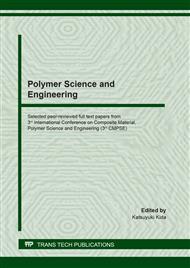[1]
F. F. Montesanoa, A. Parente, P. Santamaria, A. Sannino and F. Serio, Biodegradable Superabsorbent Hydrogel increases water retention properties of growing media and plant growth, Agriculture and Agricultural Science Procedia. 4 (2014) 451-458.
DOI: 10.1016/j.aaspro.2015.03.052
Google Scholar
[2]
E. M. Ahmed, Hydrogel, Preparation, characterization, and applications: A Review, J. of Advance Research. 6 (2015) 105-121.
Google Scholar
[3]
M. Verhulsel, M. Vignes, S. Descroix, L. Malaquin, D. M. Vignjevic and J.L. Viovy, A review of microfabrication and hydrogel engineering for micro-organs on chips, Biomaterials. 35 (2014) 1816-1832.
DOI: 10.1016/j.biomaterials.2013.11.021
Google Scholar
[4]
S. Kiatkamjornwong, Superabsorbent Polymers and Superabsorbent Polymer Composites, ScienceAsia. 33 (2007) 39-43.
Google Scholar
[5]
O. M. Jensen, Water Absorption of Superabsorbent Polymers in Cementitious Environment, International RILEM Conference on Advances on Construction Materials through Science and Engineering, RILEM Publications S.A.R.L., HongKong (2011) 22-35.
Google Scholar
[6]
T. Tsubakimoto, T. Shimomura, Y. Irie, Y. Masuda, K. Kimura and T. Hatsuda, U.S. Patent 4,734,478 (1985).
Google Scholar
[7]
F.L. Buchholz, A. T. Graham, Modern Superabsorbent Polymer Tech., Wiley-VCH, NY (1998).
Google Scholar
[8]
J. Mohammad, M. J. Zohuriaan-Mehr, and K. Kabiri, Superabsorbent Polymer Materials: A Review, Iranian Polymer Journal. 6 (2008) 451-477.
Google Scholar
[9]
F. Nnadi and C. Brave, Environmentally friendly superabsorbent polymers for water conservation in agricultural lands, J. of Soil Sci. and Environ. Manag. 2(2011) 206-211.
Google Scholar
[10]
E. M. Fayyad, M. A. Almaadeed, A. Jones and A. M. Abdullah, Evaluation Techniques for the Corrosion Resistance of Self Healing Coatings. Int. J. Electrochem. Sci., 9 (2014) 4989 -5011.
Google Scholar
[11]
J. S. Vimala1, M. Natesan and Susai Rajendran , Corrosion and Protection of Electronic Components in Different Environmental Conditions- An Overview, The Open Corrosion Journal. 2 (2009) 105-113.
DOI: 10.2174/1876503300902010105
Google Scholar
[12]
S. Prvulovic, D. Tolmac, and M. Lambic. Convection Drying in the Food Industry, Agricultural Engineering International: The CIGR Ejournal. 9 (2007) 1-12.
Google Scholar
[13]
D. Tolmac, S. Prvulovic and L. Radovanovic, Effects of Heat Transfer on Convection Dryer with Pneumatic Transport of Material, FME Transactions. 36 (2008) 45-49.
Google Scholar
[14]
M.T. Islam, B.P. Marks and F.W. Bakker-Arkema, Optimization of Commercial Ear Corn Dryers, Agricultural Engineering International: The CIGR Ejournal. 6(2004), 1-16.
Google Scholar
[15]
T.F.N. Thoruwa, C.M. Johnstone, A.D. Grant and J. Smith, Low cost CaCl2 based desiccants for solar crop drying applications, Renew Energy. 19 (2000) 513–520.
DOI: 10.1016/s0960-1481(99)00072-5
Google Scholar
[16]
D. O. Mbuge, R. Negrini, L. O. Nyakundi, S. P. Kuate, R. Bandyopadhya, W. M. Muiru, B. Torto and R. Mezzenga, Application of superabsorbent polymers (SAP) as desiccants to dry maize and reduce aflatoxin contamination, J. of Food Sci. Technol. 53 (2016) 3157–3165.
DOI: 10.1007/s13197-016-2289-6
Google Scholar
[17]
S. Odero, D. O. Mbuge, E. B. K. Mutai, G. Mutuli, Evaluation of the Effectiveness of Super Absorbent Polymers (SAPs) In Air Dehumidification for Maize Drying International Journal of Innovative Research in Engineering & Management (IJIREM). 3 (2016) ISSN: 2350-0557.
Google Scholar
[18]
J. Alaei, S. H. Boroojerdi and Z. Rabiei. Application of hydrogels in drying operation, Petroleum and Coal. 47 (2005), 32-37.
Google Scholar
[19]
A. Melendres, J. A. Antang and J. Manacob, Investigation of Superabsorbent Polymer Absorbency at Reduced Chemical Potential of Water, MATEC Web of Conferences. 268 (2019) 04010.
DOI: 10.1051/matecconf/201926804010
Google Scholar
[20]
T. K. Mudiyanselage and D. C. Neckers, Highly absorbing superabsorbent polymer, J Polym Sci A Polym Chem. 46 (2008) 1357-1364.
DOI: 10.1002/pola.22476
Google Scholar
[21]
J. Xie, X. Liu, J. Liang and Y. Luo, Swelling. properties of superabsorbent poly(acrylic acid-co-acryl amide) with different crosslinkers. J. of Polymer Science. 2009, 12(2), 602-608.
DOI: 10.1002/app.29463
Google Scholar
[22]
M. C. Joy and W. Hsu, U. S. Patent 7,163,966. (2007).
Google Scholar
[23]
Z. Liu and G.L. Rempel, Preparation of superabsorbent polymers by crosslinking Acrylic Acid and Acrylamide Copolymers, J. of Applied Polymer Science. 67 (1997), Vol 67, 1345-1353.
DOI: 10.1002/(sici)1097-4628(19970516)64:7<1345::aid-app14>3.0.co;2-w
Google Scholar
[24]
Information on http://hyperphysics.phy-astr.gsu.edu/hbase/Kinetic/relhum.html.
Google Scholar
[25]
P. J. Flory, Principles of Polymer Chemistry, Cornell University Press, New York, (1953).
Google Scholar
[26]
M. Elliott, Superabsorbent Polymers, BASF Aktiengesellshaft, Ludwigshafen Germany, (2004).
Google Scholar


